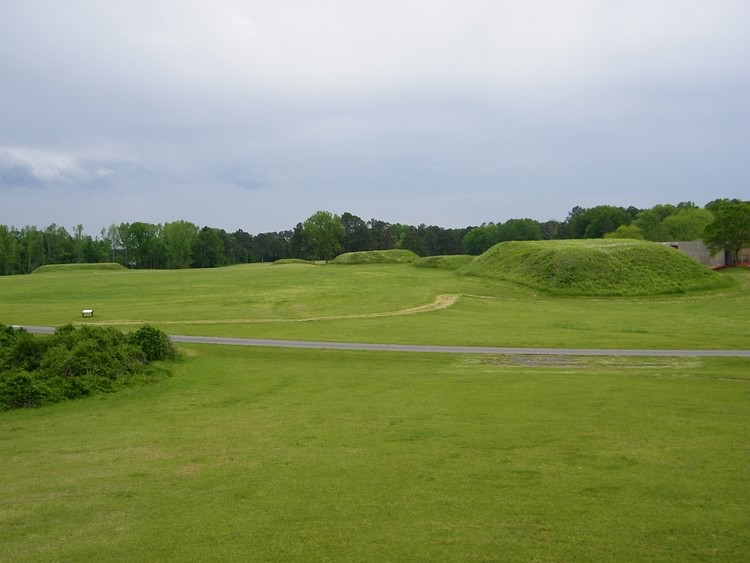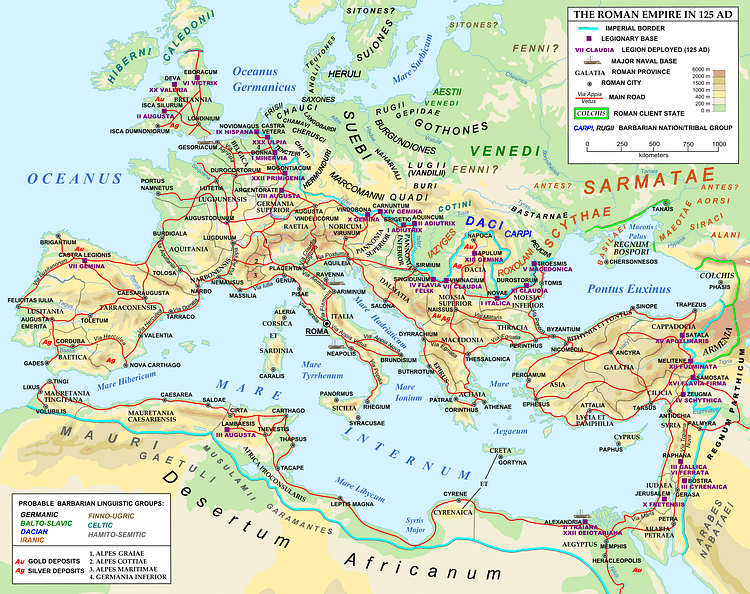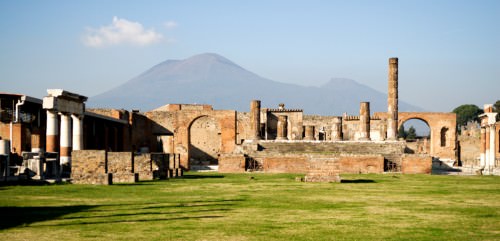Moundville › Roman Empire » Ancient origins
Articles and Definitions › Contents
- Moundville › Ancient History
- Roman Empire › Antique Origins
Ancient civilizations › Historical and archaeological sites
Moundville › Ancient History
Definition and Origins

Moundville was a site occupied by Mississippian culture from about 1000 CE until 1450 CE, in central Alabama. One of the largest settlements at the time, the site boasts what appears to have been a highly stratified society.
The town was occupied for some time, but the fall of the community was rapid. Scholars have said that most of the culture is still not entirely understood.
The Moundville Archaeological Park now rests on the site. The park itself is 320 acres and contains 26 prehistoric, Mississippian culture-era Native American earthwork mounds, burial sites, plus numerous artifacts.
A museum was erected in 1939, and it now combines some of the latest technology and over 200 artifacts to showcase one of the most significant Native American archaeological sites in the United States.
Some archaeologists believe that Moundville is a link to ancestral Chickasaw history. Moundville pottery that dates from 1100 CE to nearly 1500 CE has been found west of the Tombigbee River in Mississippi. This indicates that people from Moundville could be ancestral Chickasaws.
Roman Empire › Antique Origins
Definition and Origins

The Roman Empire, at its height (c. 117 CE), was the most extensive political and social structure in western civilization. By 285 CE the empire had grown too vast to be ruled from the central government at Rome and so was divided by Emperor Diocletian (284-305 CE) into a Western and an Eastern Empire. The Roman Empire began when Augustus Caesar (27 BCE-14 CE) became the first emperor of Rome and ended, in the west, when the last Roman emperor, Romulus Augustulus, was deposed by the Germanic King Odoacer (476 CE). In the east, it continued as the Byzantine Empire until the death of Constantine XI and the fall of Constantinople to the Ottoman Turks in 1453 CE. The influence of the Roman Empire on western civilization was profound in its lasting contributions to virtually every aspect of western culture.
THE EARLY DYNASTIES
Following the Battle of Actium in 31 BCE, Gaius Octavian Thurinus, Julius Caesar 's nephew and heir, became the first emperor of Rome and took the name Augustus Caesar. Although Julius Caesar is often regarded as the first emperor of Rome, this is incorrect; he never held the title `Emperor' but, rather, `Dictator', a title the Senate could not help but grant him, as Caesar held supreme military and political power at the time. In contrast, the Senate willingly granted Augustus the title of emperor, lavishing praise and power on him because he had destroyed Rome's enemies and brought much-needed stability.
AUGUSTUS: "I FOUND ROME A CITY OF CLAY BUT LEFT IT A CITY OF MARBLE."
Augustus ruled the empire from 31 BCE until 14 CE when he died. In that time, as he said himself, he "found Rome a city of clay but left it a city of marble." Augustus reformed the laws of the city and, by extension, the empire's, secured Rome's borders, initiated vast building projects (carried out largely by his faithful general Agrippa, who built the first Pantheon ), and secured the empire a lasting name as one of the greatest, if not the greatest, political and cultural powers in history. The Pax Romana (Roman Peace), also known as the Pax Augusta, which he initiated, was a time of peace and prosperity hitherto unknown and would last over 200 years.
Following Augustus' death, power passed to his heir, Tiberius, who continued many of the emperor's policies but lacked the strength of character and vision which so defined Augustus. This trend would continue, more or less steadily, with the emperors who followed: Caligula, Claudius, and Nero. These first five rulers of the empire are referred to as the Julio-Claudian Dynasty for the two family names they descended from (either by birth or through adoption), Julius and Claudius.Although Caligula has become notorious for his depravity and apparent insanity, his early rule was commendable as was that of his successor, Claudius, who expanded Rome's power and territory in Britain ; less so was that of Nero. Caligula and Claudius were both assassinated in office (Caligula by his Praetorian Guard and Claudius, apparently, by his wife). Nero's suicide ended the Julio-Claudian Dynasty and initiated the period of social unrest known as The Year of the Four Emperors.

Empreror Claudius or Nero
These four rulers were Galba, Otho, Vitellius, and Vespasian. Following Nero's suicide in 68 CE, Galba assumed rule (69 CE) and almost instantly proved unfit for the responsibility. He was assassinated by the Praetorian Guard. Otho succeeded him swiftly on the very day of his death, and ancient records indicate he was expected to make a good emperor. General Vitellius, however, sought power for himself and so initiated the brief civil war which ended in Otho's suicide and Vitellius' ascent to the throne.
Vitellius proved no more fit to rule than Galba had been, as he almost instantly engaged in luxurious entertainments and feasts at the expense of his duties. The legions declared for General Vespasian as emperor and marched on Rome. Vitellius was murdered by Vespasian's men, and Vespasian took power exactly one year from the day Galba had first ascended to the throne.
Vespasian founded the Flavian Dynasty which was characterized by massive building projects, economic prosperity, and expansion of the empire. Vespasian ruled from 69-79 CE, and in that time, initiated the building of the Flavian Amphitheatre(the famous Coliseum of Rome) which his son Titus (ruled 79-81 CE) would complete. Titus' early reign saw the eruption of Mount Vesuvius in 79 CE which buried the cities of Pompeii and Herculaneum.

Pompeii and Mt. Vesuivus
Ancient sources are universal in their praise for his handling of this disaster as well as the great fire of Rome in 80 CE. Titus died of a fever in 81 CE and was succeeded by his brother Domitian who ruled from 81-96 CE. Domitian expanded and secured the boundaries of Rome, repaired the damage to the city caused by the great fire, continued the building projects initiated by his brother, and improved the economy of the empire. Even so, his autocratic methods and policies made him unpopular with the Roman Senate, and he was assassinated in 96 CE.
THE FIVE GOOD EMPERORS
Domitian's successor was his advisor Nerva who founded the Nervan-Antonin Dynasty which ruled Rome 96-192 CE. This period is marked by increased prosperity owing to the rulers known as The Five Good Emperors of Rome. Between 96 and 180 CE, five exceptional men ruled in sequence and brought the Roman Empire to its height:
- Nerva (96-98 CE)
- Trajan (98-117 CE)
- Hadrian (117-138 CE)
- Antoninus Pius (138-161 CE)
- Marcus Aurelius (161-180 CE)
Under their leadership, the Roman Empire grew stronger, more stable, and expanded in size and scope. Lucius Verus and Commodus are the last two of the Nervan-Antonin Dynasty. Verus was co-emperor with Marcus Aurelius until his death in 169 CE and seems to have been fairly ineffective. Commodus, Aurelius' son and successor, was one of the most disgraceful emperors Rome ever saw and is universally depicted as indulging himself and his whims at the expense of the empire. He was strangled by his wrestling partner in his bath in 192 CE, ending the Nervan-Antonin Dynasty and raising the prefect Pertinax(who most likely engineered Commodus' assassination) to power.
THE SEVERAN DYNASTY
Pertinax governed for only three months before he was assassinated. He was followed, in rapid succession, by four others in the period known as The Year of the Five Emperors, which culminated in the rise of Septimus Severus to power. Severus ruled Rome from 193-211 CE, founded the Severan Dynasty, defeated the Parthians, and expanded the empire. His campaigns in Africa and Britain were extensive and costly and would contribute to Rome's later financial difficulties. He was succeeded by his sons Caracalla and Geta, until Caracalla had his brother murdered.

Roman Beach Attack
Caracalla ruled until 217 CE, when he was assassinated by his bodyguard. It was under Caracalla's reign that Roman citizenship was expanded to include all free men within the empire. This law was said to have been enacted as a means of raising tax revenue, simply because, after its passage, there were more people the central government could tax. The Severan Dynasty continued, largely under the guidance and manipulation of Julia Maesa (referred to as `empress'), until the assassination of Alexander Severus in 235 CE which plunged the empire into the chaos known as The Crisis of the Third Century (lasting from 235-284 CE).
TWO EMPIRES: EAST & WEST
This period, also known as The Imperial Crisis, was characterized by constant civil war, as various military leaders fought for control of the empire. The crisis has been further noted by historians for widespread social unrest, economic instability (fostered, in part, by the devaluation of Roman currency by the Severans), and, finally, the dissolution of the empire which broke into three separate regions. The empire was reunited by Aurelian (270-275 CE) whose policies were further developed and improved upon by Diocletian who established the Tetrarchy (the rule of four) to maintain order throughout the empire.
THE IMPERIAL CRISIS WAS CHARACTERIZED BY CONSTANT CIVIL WAR, AS VARIOUS MILITARY LEADERS FOUGHT FOR CONTROL OF THE EMPIRE.
Even so, the empire was still so vast that Diocletian divided it in half in 285 CE to facilitate more efficient administration. In so doing, he created the Western Roman Empire and the Eastern Roman Empire (also known as the Byzantine Empire). Since a leading cause of the Imperial Crisis was a lack of clarity in succession, Diocletian decreed that successors must be chosen and approved from the outset of an individual's rule. Two of these successors were the generals Maxentius and Constantine.Diocletian voluntarily retired from rule in 305 CE, and the tetrarchy dissolved as rival regions of the empire vied with each other for dominance. Following Diocletian's death in 311 CE, Maxentius and Constantine plunged the empire again into civil war.
CONSTANTINE & CHRISTIANITY
In 312 CE Constantine defeated Maxentius at the Battle of the Milvian Bridge and became sole emperor of both the Western and Eastern Empires (ruling from 306-337 CE). Believing that Jesus Christ was responsible for his victory, Constantine initiated a series of laws such as the Edict of Milan (317 CE) which mandated religious tolerance throughout the empire and, specifically, tolerance for the faith which came to known as Christianity.

The Colossus of Constantine
In the same way that earlier Roman emperors had claimed a special relationship with a deity to augment their authority and standing (Caracalla with Serapis, for example, or Diocletian with Jupiter ), Constantine chose the figure of Jesus Christ. At the First Council of Nicea (325 CE), he presided over the gathering to codify the faith and decide on important issues such as the divinity of Jesus and which manuscripts would be collected to form the book known today as The Bible. He stabilized the empire, revalued the currency, and reformed the military, as well as founding the city he called New Rome on the site of the former city of Byzantium (modern-day Istanbul) which came to be known as Constantinople.
He is known as Constantine the Great owing to later Christian writers who saw him as a mighty champion of their faith but, as has been noted by many historians, the honorific could as easily be attributed to his religious, cultural, and political reforms, as well as his skill in battle and his large-scale building projects. After his death, his sons inherited the empire and, fairly quickly, embarked on a series of conflicts with each other which threatened to undo all that Constantine had accomplished.
His three sons, Constantine II, Constantius II, and Constans divided the Roman Empire between them but soon fell to fighting over which of them deserved more. In these conflicts, Constantine II and Constans were killed. Constantius II died later after naming his cousin Julian his successor and heir. Emperor Julian ruled for only two years (361-363 CE) and, in that time, tried to return Rome to her former glory through a series of reforms aimed at increasing efficiency in government.
As a Neo-Platonic philosopher, Julian rejected Christianity and blamed the faith; and Constantine's adherence to it, for the decline of the empire. While officially proclaiming a policy of religious tolerance, Julian systematically removed Christians from influential government positions, banned the teaching and spread of the religion, and barred Christians from military service.His death, while on campaign against the Persians, ended the dynasty Constantine had begun. He was the last pagan emperor of Rome and came to be known as `Julian the Apostate' for his opposition to Christianity.

Byzantine Empire c. 460 CE
After the brief rule of Jovian, who re-established Christianity as the dominant faith of the empire and repealed Julian's various edicts, the responsibility of emperor fell to Theodosius I. Theodosius I (379-395 CE) took Constantine's and Jovian's religious reforms to their natural ends, outlawed pagan worship throughout the empire, closed the schools and universities, and converted pagan temples into Christian churches.
THE UNITY OF SOCIAL DUTIES & RELIGIOUS BELIEF WHICH PAGANISM PROVIDED WAS SEVERED BY THE INSTITUTION OF CHRISTIANITY.
It was during this time that Plato ’s famous Academy was closed by Theodosius' decree. Many of his reforms were unpopular with both the Roman aristocracy and the common people who held to the traditional values of pagan practice. The unity of social duties and religious belief which paganism provided was severed by the institution of a religion which removed the gods from the earth and human society and proclaimed only one God who ruled from the heavens. Theodosius I devoted so much effort to promoting Christianity that he seems to have neglected other duties as emperor and would be the last to rule both Eastern and Western Empires.
THE FALL OF THE ROMAN EMPIRE
From 376-382 CE, Rome fought a series of battles against invading Goths known today as the Gothic Wars. At the Battle of Adrianople, 9 August 378 CE, the Roman Emperor Valens was defeated, and historians mark this event as pivotal in the decline of the Western Roman Empire. Various theories have been suggested as to the cause of the empire's fall but, even today, there is no universal agreement on what those specific factors were. Edward Gibbon has famously argued in his The History of the Decline and Fall of the Roman Empire that Christianity played a pivotal role, in that the new religion undermined the social mores of the empire which paganism provided.
The theory that Christianity was a root cause in the empire's fall was debated long before Gibbon, however, as Orosiusargued Christianity's innocence in Rome's decline as early as 418 CE. Orosius claimed it was primarily paganism itself and pagan practices which brought about the fall of Rome. Other influences which have been noted range from the corruption of the governing elite to the ungovernable vastness of the empire to the growing strength of the Germanic tribes and their constant incursions into Rome. The Roman military could no longer safeguard the borders as efficiently as they once had nor could the government as easily collect taxes in the provinces. The arrival of the Visigoths in the empire in the third century CE and their subsequent rebellions has also been cited a contributing factor in the decline.

Invasions of the Roman Empire
The Western Roman Empire officially ended 4 September 476 CE, when Emperor Romulus Augustus was deposed by the Germanic King Odoacer (though some historians date the end as 480 CE with the death of Julius Nepos). The Eastern Roman Empire continued on as the Byzantine Empire until 1453 CE, and though known early on as simply `the Roman Empire', it did not much resemble that entity at all. The Western Roman Empire would become re-invented later as The Holy Roman Empire, but that construct, also, was far removed from the Roman Empire of antiquity and was an `empire' in name only.
LEGACY OF THE ROMAN EMPIRE
The inventions and innovations which were generated by the Roman Empire profoundly altered the lives of the ancient people and continue to be used in cultures around the world today. Advancements in the construction of roads and buildings, indoor plumbing, aqueducts, and even fast-drying cement were either invented or improved upon by the Romans. The calendar used in the West derives from the one created by Julius Caesar, and the names of the days of the week (in the romance languages) and months of the year also come from Rome.
Apartment complexes (known as `insula), public toilets, locks and keys, newspapers, even socks all were developed by the Romans as were shoes, a postal system (modeled after the Persians), cosmetics, the magnifying glass, and the concept of satire in literature. During the time of the empire, significant developments were also advanced in the fields of medicine, law, religion, government, and warfare. The Romans were adept at borrowing from, and improving upon, those inventions or concepts they found among the indigenous populace of the regions they conquered. It is therefore difficult to say what is an `original' Roman invention and what is an innovation on a pre-existing concept, technique, or tool. It can safely be said, however, that the Roman Empire left an enduring legacy which continues to affect the way in which people live even today.
MAP
LICENSE:
Article based on information obtained from these sources:with permission from the Website Ancient History Encyclopedia
Content is available under License Creative Commons: Attribution-NonCommercial-ShareAlike 3.0 Unported. CC-BY-NC-SA License